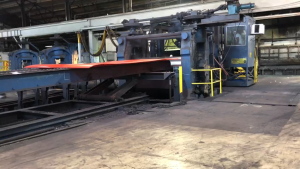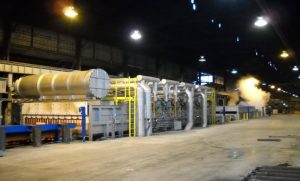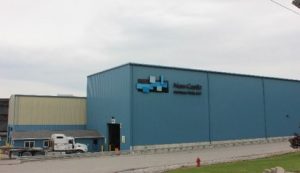Operational and Commercial Excellence are hallmark characteristics of New Castle, and our plates are produced to one of the quickest and most reliable lead times compared to anyone in the industry. Because plate is produced one at a time, we can produce the custom thickness, width and length in the grades that you need to fit your application.
Production of stainless steel plate begins at the melt shop. Due to the scale of the business, NCSP purchases continuous cast slabs of the highest quality to specified chemical compositions from external vendors with whom we have established, long term relationships. These continuous cast slabs are produced at various sizes so NCSP can most efficiently utilize material to produce plate between 3/16″ thick and 6″ thick with optimum properties and yield.

NCSP also utilizes world class rolling assets to convert the continuous cast slab to plate. Slab is sent to the rolling mill where it is subsequently divided into smaller cuts to produce the tailored size to the customer’s requirements. Once the slab is cut, it is sent to the mill where it is processed to plate in accordance with exacting NCSP defined standards. The slabs are heated prior to rolling and then spread to width and rolled to final thickness in successive passes on a 4-high mill. While a high percentage of NCSP products are rolled direct to finished thickness externally, a critical operation in New Castle is the NCSP Finish Mill. The Finish Mill in New Castle is utilized to finish roll higher alloyed, harder to roll special grades to produce to 3/16″ thick at 96″ wide.

Once the plates are rolled they are sent to be finished at the NCSP mill in New Castle, Indiana. While the New Castle site is over 100 years old and has a storied history in the steel industry, the facility houses state of the art, world class finishing assets designed to produce the widest, thickest and longest plates in North America with superior quality and surface finish. In 2010, the New Castle mill completed a $58 million capital investment program that increased on-time delivery, improved quality and consistency, enhanced capabilities, and made for safer and more environmentally responsible operations. The upgrades included new equipment to streamline the plate production process, including a new ASBF line (with in-line annealing, shot blasting, and leveling), the MBSP line (spray pickling line for up to 6″ thick plate and up to 144″ wide), and improvements to the 120″ pickling line.
Subsequent to hot rolling, whether plates are hot rolled externally or on the New Castle Finish Mill, the next step is annealing. During the annealing process plates are heated to a specified temperature for a predetermined amount of time. The purpose of the annealing process is to achieve the optimum mechanical properties by recrystallizing the grain structure of the steel and growing the grains in the microstructure. Additionally, the anneal process is dissolving chromium carbides, other precipitates and intermetallic phases to produce the maximum level of corrosion resistance and ductility for each grade we produce. Upon discharge, plates are rapidly cooled in air or water quenched so that the formation of these undesirable phases and precipitates are minimized after anneal. The water quenching process employed by NCSP is particularly ideal for the production of duplex and high alloyed austenitic grades of stainless steel as the spray quench begins immediately after discharge so there is no delay that would permit reformation of these phases.
The finishing plant in New Castle has dual flow production, with annealing and finishing operations in two separate bays. The “Main Bay” begins the ASBF Line (an in-line annealing furnace, roller leveler, and shot blaster). The ASBF furnace is a walking beam style furnace equipped with forced air and water mist cooling. The annealing operation is followed by a roller leveler type flattening operation and a shot blaster. Once plates are discharged from the ASBF line, they are taken to the plasma arc cutting center where the final dimensions are cut. The plasma cut plates are deburred and then staged for the Main Bay Spray Pickle (MBSP) operation. The MBSP is an enclosed vertical spray pickling and final inspection line that is designed to process plate up to 6″ thick. Since the pickling chamber is enclosed, the fumes are captured and sent to the six stage fume scrubber for remediation.
The 120″ Bay is comprised of 3 Salem annealing furnaces, two of which are equipped with an immediate water quench system. After anneal, plates are sent to be cut to final size at the mechanical shearing operation, with plates less than 3/8″ thick diverted to be flattened at the stretcher leveling operation prior to shearing. The stretcher leveler is one of the most powerful one of its kind in the world and is capable of producing the best light gauge flatness in the industry. After shearing, plates are processed on the 120″ Line, which has in-line roller leveling, vertical shot blasting, vertical pickling, rinsing, drying, and final inspection.

After pickling and final inspection, plates are built into shipping loads in the warehouse. At the same time, samples are being tested in accordance with standard and customer specification requirements at our fully equipped in-house metallurgical laboratory. Once plates are built into loads, the loads are sent to the shipping bay to await shipment to the customer. The shipping bay is equipped with a 70 ton crane which can safely and efficiently load a flat bed truck in one maneuver. Once loaded the driver will secure the load to the bed and cover with a tarp to minimize contamination. All paperwork, including the Bill of Lading, Packing List and Certified Material Test Reports, is sent with the driver (and can be emailed upon request), and the load is on its way to the customer – ON TIME!



